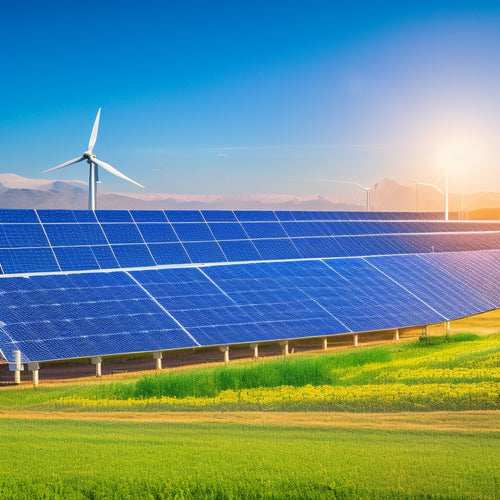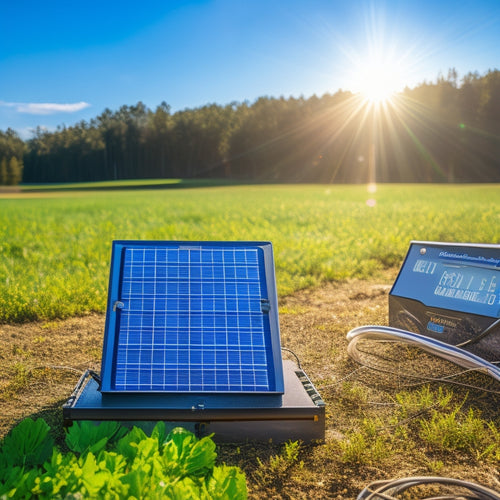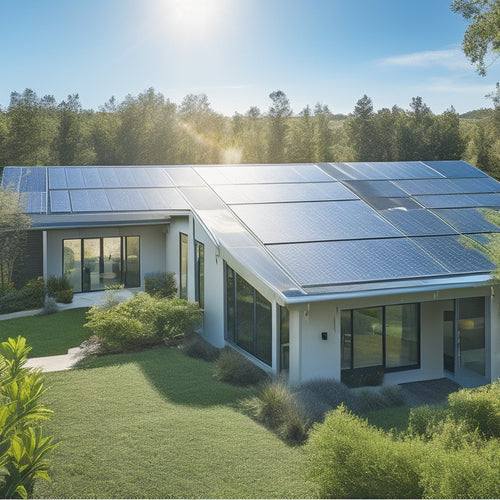
Maximizing Home Energy Independence With Smart Systems
Share
You can access maximum home energy independence by utilizing the power of smart systems that integrate solar energy, energy storage, and efficient energy management to reduce your reliance on the grid. By embracing innovations like advanced solar panels, home energy monitoring systems, and smart battery management, you can optimize your energy usage and storage. Implementing energy efficiency optimization tools and real-time energy usage tracking helps you identify areas for improvement. Furthermore, solar system performance analysis and maximizing energy storage capacity enable you to make informed decisions about your energy management strategy, and taking these steps will put you on the path to achieving true energy autonomy.
Overview
- Abundant sunlight on roofs can be harnessed with innovative solar panels, reducing reliance on the grid and enhancing energy independence.
- Smart battery management systems optimize energy storage, allowing for efficient charging and discharging, and selling excess energy back to the grid.
- Real-time energy usage tracking provides visibility into consumption patterns, enabling informed decision-making and proactive energy management strategies.
- Energy efficiency optimization tools, such as energy audits and smart thermostats, help identify and minimize inefficiencies, reducing energy waste and consumption.
- Advanced home energy monitoring systems integrate with smart grid systems, enabling responsive energy management and maximizing energy independence.
Unlocking Solar Power Potential
Your roof receives an abundance of sunlight every day, and utilizing this energy can greatly reduce your reliance on the grid. By leveraging solar power, you can take a significant step towards energy independence.
Recent solar panel innovations have made it more efficient and affordable to generate electricity. High-efficiency panels, durable mounting systems, and reliable inverters are vital for DIY installations Key Considerations for DIY Solar Systems.
Community solar initiatives and renewable energy incentives can further offset the costs. Energy policy impacts also play an important role, as favorable policies can provide additional benefits.
With various solar financing options and grid integration solutions available, you can seamlessly integrate solar power into your daily life. Stay updated on the latest solar technology advancements to maximize your energy independence strategies.
Home Energy Monitoring Systems
Frequently, homeowners overlook the significance of monitoring their energy consumption, leading to inefficient energy use and higher utility bills.
By installing a home energy monitoring system, you'll gain essential understanding into your energy consumption patterns, identifying areas for improvement and optimizing your energy allocation strategies.
With advanced data analytics platforms real-time performance tracking, you can pinpoint inefficiencies and make data-driven decisions to maximize your energy independence.
Integration with smart grid systems enables real-time monitoring, allowing you to respond to changes in energy demand and capitalize on renewable energy incentives.
Compatibility with home automation systems streamlines your energy management, while user engagement strategies and demand response programs encourage sustainable habits.
Leveraging predictive analytics tools, you'll make data-driven decisions to maximize your energy independence.
Smart Battery Management Systems
Three key components comprise an extensive home energy independence strategy: home energy monitoring systems, smart battery management systems, and renewable energy sources.
You're likely familiar with the first component, but now it's time to investigate the second: smart battery management systems. These systems optimize your energy storage by regulating charge and discharge rates, ensuring your batteries last longer and perform more efficiently.
Regular monitoring of battery state of charge (SOC) and depth of discharge (DOD) prevents overcharging and undercharging, and setting a discharge limit extends solar battery lifespan and maintains health.
Recent battery technology advancements have made it possible to store more energy in smaller, more cost-effective packages.
Smart battery management systems also enable seamless smart grid integration, allowing you to sell excess energy back to the grid and offset your consumption.
Energy Efficiency Optimization Tools
A well-designed energy independence strategy relies on a trifecta of key components, and now that we've examined smart battery management systems, it's time to investigate the next crucial element: energy efficiency enhancement tools. These tools help you identify areas of inefficiency and enhance your energy usage.
| Energy Efficiency Enhancement Tools | Description |
|---|---|
| Energy Audits | Identify areas of energy inefficiency in your home |
| Insulation Upgrades | Reduce heat loss and energy waste |
| Smart Thermostats | Regulate temperature for ideal energy use |
| Demand Response | Adjust energy usage during peak hours |
| Energy Efficient Appliances | Replace old appliances with energy-saving ones |
Real-Time Energy Usage Tracking
As you've optimized your energy efficiency with tools like smart thermostats and energy-efficient appliances, it's now imperative to gain real-time visibility into your energy usage patterns.
This is where real-time energy usage tracking comes in. With advanced smart systems, you can monitor your energy consumption in real-time, allowing you to identify areas of inefficiency and make adjustments on the fly.
Real-time analytics provide you with detailed observations into your energy usage, enabling you to make informed decisions about your energy consumption.
Solar System Performance Analysis
How efficiently is your solar system performing? To maximize home energy independence, you need to monitor and analyze your solar system's performance regularly.
This involves tracking key metrics such as solar panel efficiency, energy output, and system uptime. Advanced smart systems can provide real-time data on these metrics, allowing you to identify areas for improvement.
By integrating your solar system with other renewable energy sources, you can optimize your energy production and reduce reliance on the grid.
Regular performance analysis helps you detect potential issues early, ensuring your system operates at peak efficiency.
This data-driven approach enables you to make informed decisions, increasing your energy independence and reducing your carbon footprint.
Maximizing Energy Storage Capacity
You've installed a solar system and are generating clean energy, but you're not yet maximizing your energy independence.
To take the next step, you'll need to optimize your energy storage capacity, which involves fine-tuning your battery performance and increasing storage capacity.
Optimize Battery Performance
Optimizing battery performance is vital to maximizing energy storage capacity, as it directly impacts the overall efficiency of your home's energy independence system.
To achieve this, you'll need to focus on battery longevity techniques. One important aspect is charging cycle optimization, which involves managing the depth and frequency of battery discharge. By limiting the number of deep discharges and avoiding extreme temperatures, you can greatly extend the lifespan of your batteries.
Additionally, implementing smart charging algorithms can help optimize energy storage and reduce wear and tear on your batteries.
Increase Storage Capacity
With a fully optimized battery performance in place, the next crucial step in maximizing home energy independence is to increase storage capacity.
You'll want to assess your energy needs and determine the ideal storage capacity for your home. This involves evaluating your energy usage patterns, the size of your renewable energy system, and local energy market fluctuations.
By doing so, you can select the most suitable energy storage technologies to support your renewable energy integration. A larger storage capacity guarantees you can store excess energy generated during the day for use during periods of low energy production, further reducing your reliance on the grid.
This strategic approach allows you to utilize the full potential of your renewable energy system, achieving greater energy independence and freedom.
Frequently Asked Questions
Can I Integrate My Smart Home System With Existing Energy Infrastructure?
You can integrate your smart home system with existing energy infrastructure, leveraging system interoperability to streamline energy management and optimize resource allocation, ensuring seamless communication between devices and enabling you to take control of your energy usage.
How Do I Ensure Cybersecurity for My Smart Energy System?
When hackers breached a major energy grid, 200,000 users lost power; you won't be one of them. Guarantee your smart energy system's cybersecurity by implementing data encryption, network security, device authentication, and user awareness measures to safeguard your energy freedom.
Are Smart Energy Systems Compatible With Older Homes?
You can integrate smart energy systems into older homes, leveraging home automation to enhance energy efficiency, but it may require retrofitting and careful planning to guarantee seamless compatibility with existing infrastructure.
Can I Monitor My Energy Usage Remotely Through an App?
Did you know that 70% of homeowners want more control over their energy usage? You can! With smart energy systems, you can monitor your energy usage remotely through an app, accessing real-time tracking and energy analytics to optimize your consumption and gain true energy independence.
What Kind of Maintenance Is Required for Smart Energy Systems?
You'll need to perform routine system upgrades and schedule regular performance checks to guarantee your smart energy system runs efficiently, which can be done remotely or through on-site visits, depending on the system's complexity and your personal preferences.
Ready to Buy
By integrating these smart systems, you're not just utilizing solar power - you're orchestrating a concert of energy efficiency. Each component works in harmony to maximize your home's energy independence, like a skilled conductor leading a virtuoso performance. With real-time tracking, optimization tools, and smart battery management, you're in control, making the most of the sun's energy and storing it for a rainy day. Your home becomes a self-sustaining haven, where energy independence is the ultimate melody.
Related Posts
-

The Role of Battery Monitoring Systems in Renewable Energy
Battery monitoring systems play an essential role in renewable energy by enhancing system longevity and optimizing pe...
-

Choosing the Right Solar Power Charge Controller
Choosing the right solar power charge controller is crucial for maximizing energy efficiency and extending battery li...
-

Installing Metal Solar Roofs for Maximum Energy Efficiency
Installing metal solar roofs can drastically enhance your home's energy efficiency and durability. These roofs withst...


